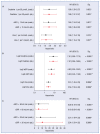Renal dysfunction and outcome in left ventricular non-compaction
- PMID: 36385602
- PMCID: PMC10635721
- DOI: 10.5603/CJ.a2022.0105
Renal dysfunction and outcome in left ventricular non-compaction
Abstract
Background: While renal function has been observed to inversely correlate with clinical outcome in other cardiomyopathies, its prognostic significance in patients with left ventricular non-compaction cardiomyopathy (LVNC) has not been investigated. The aim of this study was to determine the prognostic value of renal function in LVNC patients.
Methods: Patients with isolated LVNC as diagnosed by echocardiography and/or magnetic resonance imaging in 4 Swiss centers were retrospectively analyzed for this study. Values for creatinine, urea, and estimated glomerular filtration rate (eGFR) as assessed by the CKD-EPI 2009 formula were collected and analyzed by a Cox regression model for the occurrence of a composite endpoint (death or heart transplantation).
Results: During the median observation period of 7.4 years 23 patients reached the endpoint. The ageand gender-corrected hazard ratios (HR) for death or heart transplantation were: 1.9 (95% confidence interval [CI] 1.4-2.6) for each increase over baseline creatinine level of 30 μmol/L (p < 0.001), 1.6 (95% CI 1.2-2.2) for each increase over baseline urea level of 5 mmol/L (p = 0.004), and 3.6 (95% CI 1.9-6.9) for each decrease below baseline eGFR level of 30 mL/min (p ≤ 0.001). The HR (log2) for every doubling of creatinine was 7.7 (95% CI 3-19.8; p < 0.001), for every doubling of urea 2.5 (95% CI 1.5-4.3; p < 0.001), and for every bisection of eGFR 5.3 (95% CI 2.4-11.6; p < 0.001).
Conclusions: This study provides evidence that in patients with LVNC impairment in renal function is associated with an increased risk of death and heart transplantation suggesting that kidney function assessment should be standard in risk assessment of LVNC patients.
Keywords: creatinine; estimated glomerular filtration rate; heart failure; kidney; prognosis; renal function; urea.
Conflict of interest statement
Figures



References
-
- Maron BJ, Towbin JA, Thiene G, et al. Contemporary definitions and classification of the cardiomyopathies: an American Heart Association Scientific Statement from the Council on Clinical Cardiology, Heart Failure and Transplantation Committee; Quality of Care and Outcomes Research and Functional Genomics and Translational Biology Interdisciplinary Working Groups; and Council on Epidemiology and Prevention. Circulation. 2006;113(14):1807–1816. doi: 10.1161/CIRCULATIONAHA.106.174287. - DOI - PubMed
MeSH terms
Substances
LinkOut - more resources
Full Text Sources
Medical
Research Materials
Miscellaneous

